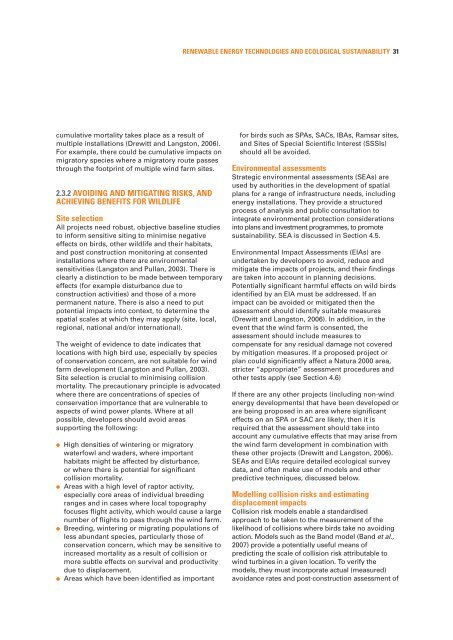Meeting Europe's renewable energy targets in harmony with - RSPB
Meeting Europe's renewable energy targets in harmony with - RSPB
Meeting Europe's renewable energy targets in harmony with - RSPB
You also want an ePaper? Increase the reach of your titles
YUMPU automatically turns print PDFs into web optimized ePapers that Google loves.
RENEWABLE ENERGY TECHNOLOGIES AND ECOLOGICAL SUSTAINABILITY 31<br />
cumulative mortality takes place as a result of<br />
multiple <strong>in</strong>stallations (Drewitt and Langston, 2006).<br />
For example, there could be cumulative impacts on<br />
migratory species where a migratory route passes<br />
through the footpr<strong>in</strong>t of multiple w<strong>in</strong>d farm sites.<br />
2.3.2 AVOIDING AND MITIGATING RISKS, AND<br />
ACHIEVING BENEFITS FOR WILDLIFE<br />
Site selection<br />
All projects need robust, objective basel<strong>in</strong>e studies<br />
to <strong>in</strong>form sensitive sit<strong>in</strong>g to m<strong>in</strong>imise negative<br />
effects on birds, other wildlife and their habitats,<br />
and post construction monitor<strong>in</strong>g at consented<br />
<strong>in</strong>stallations where there are environmental<br />
sensitivities (Langston and Pullan, 2003). There is<br />
clearly a dist<strong>in</strong>ction to be made between temporary<br />
effects (for example disturbance due to<br />
construction activities) and those of a more<br />
permanent nature. There is also a need to put<br />
potential impacts <strong>in</strong>to context, to determ<strong>in</strong>e the<br />
spatial scales at which they may apply (site, local,<br />
regional, national and/or <strong>in</strong>ternational).<br />
The weight of evidence to date <strong>in</strong>dicates that<br />
locations <strong>with</strong> high bird use, especially by species<br />
of conservation concern, are not suitable for w<strong>in</strong>d<br />
farm development (Langston and Pullan, 2003).<br />
Site selection is crucial to m<strong>in</strong>imis<strong>in</strong>g collision<br />
mortality. The precautionary pr<strong>in</strong>ciple is advocated<br />
where there are concentrations of species of<br />
conservation importance that are vulnerable to<br />
aspects of w<strong>in</strong>d power plants. Where at all<br />
possible, developers should avoid areas<br />
support<strong>in</strong>g the follow<strong>in</strong>g:<br />
●<br />
●<br />
●<br />
●<br />
High densities of w<strong>in</strong>ter<strong>in</strong>g or migratory<br />
waterfowl and waders, where important<br />
habitats might be affected by disturbance,<br />
or where there is potential for significant<br />
collision mortality.<br />
Areas <strong>with</strong> a high level of raptor activity,<br />
especially core areas of <strong>in</strong>dividual breed<strong>in</strong>g<br />
ranges and <strong>in</strong> cases where local topography<br />
focuses flight activity, which would cause a large<br />
number of flights to pass through the w<strong>in</strong>d farm.<br />
Breed<strong>in</strong>g, w<strong>in</strong>ter<strong>in</strong>g or migrat<strong>in</strong>g populations of<br />
less abundant species, particularly those of<br />
conservation concern, which may be sensitive to<br />
<strong>in</strong>creased mortality as a result of collision or<br />
more subtle effects on survival and productivity<br />
due to displacement.<br />
Areas which have been identified as important<br />
for birds such as SPAs, SACs, IBAs, Ramsar sites,<br />
and Sites of Special Scientific Interest (SSSIs)<br />
should all be avoided.<br />
Environmental assessments<br />
Strategic environmental assessments (SEAs) are<br />
used by authorities <strong>in</strong> the development of spatial<br />
plans for a range of <strong>in</strong>frastructure needs, <strong>in</strong>clud<strong>in</strong>g<br />
<strong>energy</strong> <strong>in</strong>stallations. They provide a structured<br />
process of analysis and public consultation to<br />
<strong>in</strong>tegrate environmental protection considerations<br />
<strong>in</strong>to plans and <strong>in</strong>vestment programmes, to promote<br />
susta<strong>in</strong>ability. SEA is discussed <strong>in</strong> Section 4.5.<br />
Environmental Impact Assessments (EIAs) are<br />
undertaken by developers to avoid, reduce and<br />
mitigate the impacts of projects, and their f<strong>in</strong>d<strong>in</strong>gs<br />
are taken <strong>in</strong>to account <strong>in</strong> plann<strong>in</strong>g decisions.<br />
Potentially significant harmful effects on wild birds<br />
identified by an EIA must be addressed. If an<br />
impact can be avoided or mitigated then the<br />
assessment should identify suitable measures<br />
(Drewitt and Langston, 2006). In addition, <strong>in</strong> the<br />
event that the w<strong>in</strong>d farm is consented, the<br />
assessment should <strong>in</strong>clude measures to<br />
compensate for any residual damage not covered<br />
by mitigation measures. If a proposed project or<br />
plan could significantly affect a Natura 2000 area,<br />
stricter “appropriate” assessment procedures and<br />
other tests apply (see Section 4.6)<br />
If there are any other projects (<strong>in</strong>clud<strong>in</strong>g non-w<strong>in</strong>d<br />
<strong>energy</strong> developments) that have been developed or<br />
are be<strong>in</strong>g proposed <strong>in</strong> an area where significant<br />
effects on an SPA or SAC are likely, then it is<br />
required that the assessment should take <strong>in</strong>to<br />
account any cumulative effects that may arise from<br />
the w<strong>in</strong>d farm development <strong>in</strong> comb<strong>in</strong>ation <strong>with</strong><br />
these other projects (Drewitt and Langston, 2006).<br />
SEAs and EIAs require detailed ecological survey<br />
data, and often make use of models and other<br />
predictive techniques, discussed below.<br />
Modell<strong>in</strong>g collision risks and estimat<strong>in</strong>g<br />
displacement impacts<br />
Collision risk models enable a standardised<br />
approach to be taken to the measurement of the<br />
likelihood of collisions where birds take no avoid<strong>in</strong>g<br />
action. Models such as the Band model (Band et al.,<br />
2007) provide a potentially useful means of<br />
predict<strong>in</strong>g the scale of collision risk attributable to<br />
w<strong>in</strong>d turb<strong>in</strong>es <strong>in</strong> a given location. To verify the<br />
models, they must <strong>in</strong>corporate actual (measured)<br />
avoidance rates and post-construction assessment of
















